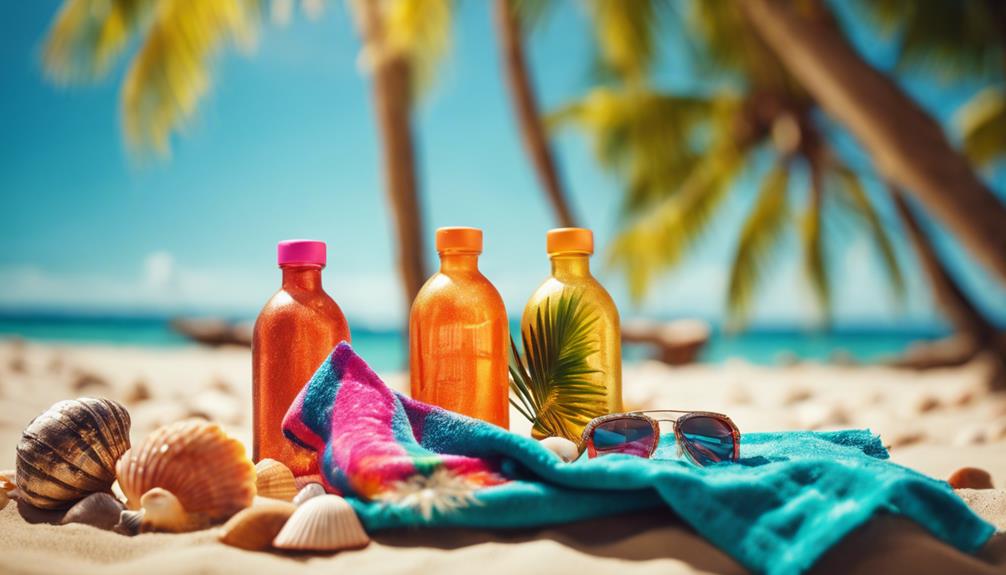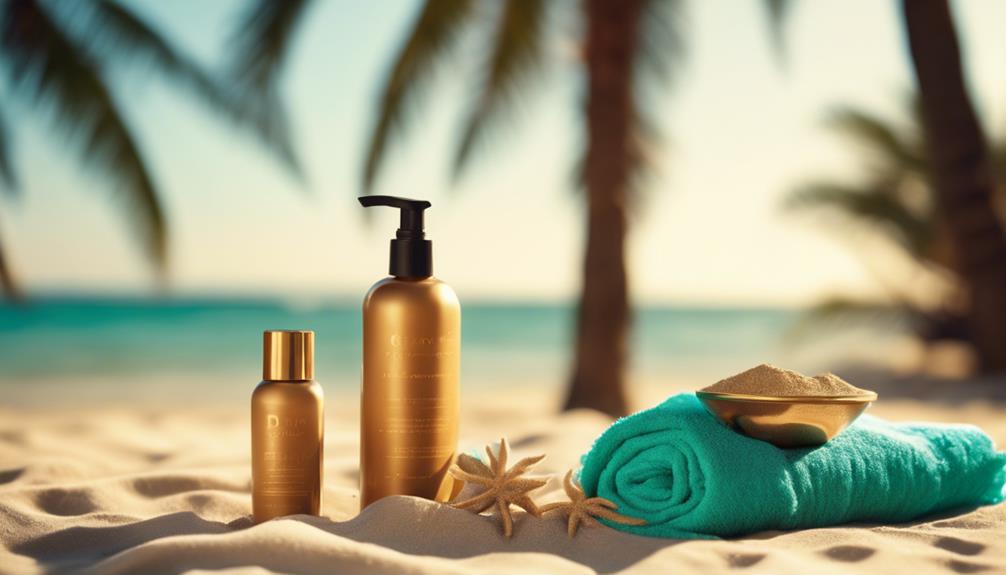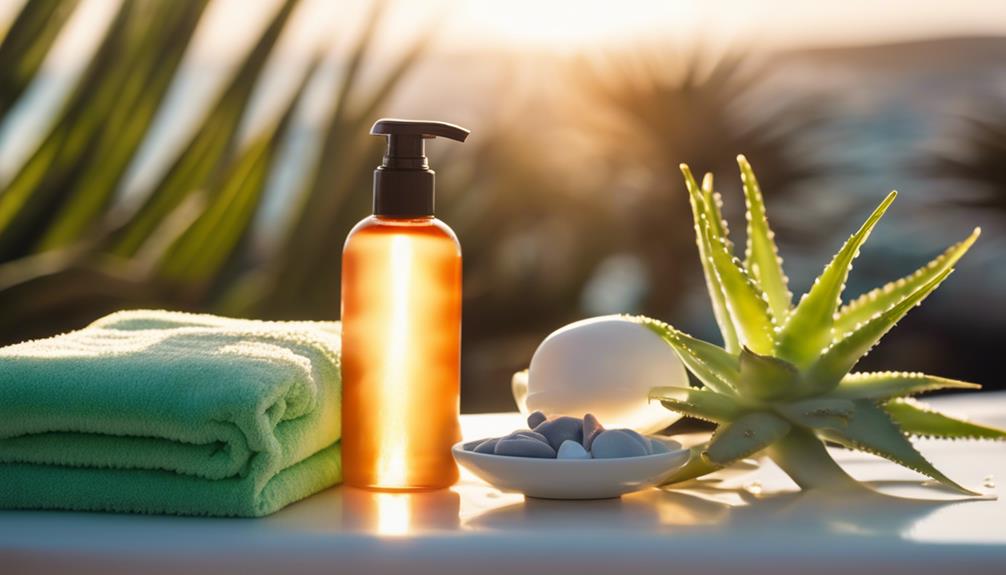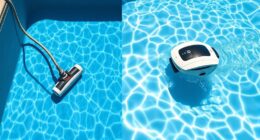The Moon Tanning Phenomenon is all about enjoying the enchanting night sky, even if it won't actually give you a tan. Moonlight is just reflected sunlight and doesn't provide the UV rays necessary for real tanning. Instead, people are drawn to nighttime gatherings, like beach parties under a full moon, to soak up the ambiance and create memorable experiences. While there's minimal risk of skin damage, it's still wise to protect your skin. So why not embrace the magic of the moonlit nights? There's much more to this trend than meets the eye, so keep exploring for the exciting details!
Key Takeaways
- Moon tanning is a romantic notion, but moonlight lacks the UV radiation required for effective tanning and skin damage prevention.
- Full moons provide bright moonlight, creating an enchanting atmosphere for nighttime activities, but not for tanning.
- Nighttime tanning promotes relaxation and social bonding, offering a unique experience under the stars without the risks of UV exposure.
- Self-tanning products can safely mimic a bronzed look without the dangers associated with sunlight, enhancing nighttime radiance.
The Science Behind Moon Tanning
Moonlight, though beautiful and enchanting, simply doesn't have the ultraviolet (UV) radiation needed to trigger the tanning process in your skin. Fundamentally, moonlight is just sunlight that's reflected off the moon's surface, and this reflection absorbs most of the UV rays. As a result, the UV levels that reach Earth from moonlight are minimal, making it virtually impossible for you to tan under its glow.
Tanning is your skin's defense mechanism against UV exposure from the sun. When your skin encounters UV light, it stimulates the production of melanin, the pigment responsible for tanning. However, the DNA repair processes in your skin cells take precedence over melanin production. Key proteins like MITF and ATM play significant roles in this intricate response, regulating both DNA repair and pigmentation.
While you might wonder about moonlight's effects over extended periods, research suggests that prolonged exposure could lead to minimal skin damage over hundreds of years. But under normal conditions, your skin repairs itself quickly, preventing any significant harm.
Optimal Moon Tanning Dates

When planning your nights out to enjoy the moon's glow, consider that ideal moon tanning dates align with the full moon, even though you won't actually achieve a tan. The full moon is when the moon shines its brightest, creating the perfect atmosphere for nighttime activities.
Many people believe that the days leading up to or immediately following a full moon are also suitable for moon tanning. However, it's crucial to remember that, despite the romantic allure of moonlight, it lacks the necessary UV radiation to induce tanning.
While it's true that moonlight is soothing and beautiful, studies confirm that prolonged exposure doesn't provide any tanning benefits. In fact, the risk of skin damage from moonlight is minimal compared to sunlight.
So, while you won't walk away with a sun-kissed glow, you can still enjoy the serene ambiance of a full moon night. Consider gathering your friends for a moonlit picnic or a nighttime stroll, and embrace the enjoyment of the lunar experience.
Just remember, moon tanning won't give you the bronze skin you might be hoping for, but it can certainly add a magical touch to your evenings.
Enhancing Your Moon Tanning Experience

Transform your nighttime outings into memorable experiences by embracing the enchanting atmosphere of moonlit gatherings. While moonlight doesn't provide the tanning benefits you might hope for, you can still enjoy the night in style. Instead of focusing on achieving a tan, consider the charm of the surroundings. Create an inviting ambiance with soft lighting, cozy blankets, and good company.
If you're looking to enhance your glow, think about using self-tanning products. These can give you that bronzed look without the risks associated with UV exposure. Apply these products before your moonlit events to guarantee a stunning appearance under the night sky.
Additionally, combine your evening outings with daytime sun exposure. Make the most of safe sun exposure during the day, using sunscreen to protect your skin from potential damage. This way, you'll be ready to flaunt your natural radiance at night while enjoying the mystical allure of moonlight.
Safety Tips for Night Tanners

When you're enjoying the moonlight, it's essential to keep skin protection in mind.
While moonlight won't tan your skin, you still need to be aware of potential risks and myths surrounding nighttime exposure.
Staying hydrated and nurturing your skin post-exposure is just as important for your overall skin health.
Skin Protection Essentials
To protect your skin during nighttime activities, it's important to understand that moonlight doesn't provide the UV radiation needed for tanning, but taking precautions can still be beneficial. Skin protection essentials should be a priority, even when you're outdoors after dark.
Daily application of a broad-spectrum sunscreen with an SPF of at least 15 is vital, as incidental UV exposure can happen even in low-light conditions.
Try to avoid direct exposure to moonlight during its peak hours—when it's brightest—to minimize any theoretical skin damage, although the risk is largely negligible. Wearing protective clothing, like long sleeves and wide-brimmed hats, can also help reduce any minimal risks associated with nighttime exposure.
Remember to conduct regular skin checks and stay aware of your skin health. Cumulative exposure to various light sources, including moonlight, can impact skin integrity over time.
Moonlight Myths Debunked
Many people mistakenly believe that moonlight can tan the skin, but this myth is easily debunked with a little understanding of how light works. Moonlight is just reflected sunlight and lacks the necessary ultraviolet (UV) radiation to cause any tanning effect. So, while you might find the idea of moon tanning appealing, it's vital to know that it simply doesn't happen.
Prolonged exposure to moonlight over centuries could theoretically lead to skin damage, but normal exposure leads to quick skin repair with minimal effects. The World Health Organization confirms that UV radiation from the sun is the primary culprit behind skin damage and tanning. So, if you're looking to achieve a tanned look, relying on moonlight won't cut it.
It's also important to be aware of the risks associated with other tanning methods, like tanning beds, which emit harmful UVA rays linked to increased skin cancer risk.
Always prioritize your skin's health and stay informed about the dangers of UV exposure, whether from the sun or artificial sources. Enjoy your nights out, but remember: moonlight won't give you that tan you're after!
Hydration and Care
Staying hydrated is essential for maintaining healthy skin, especially after any exposure to UV light, even from moonlight. To keep your skin in top condition while night tanning, follow these safety tips:
Drink plenty of water before and after your tanning sessions to support overall skin hydration.
Apply a high-quality moisturizer immediately after tanning to aid skin recovery and enhance barrier function.
Incorporate antioxidant-rich products into your skincare routine to combat potential free radical damage from UV exposure.
Perform a patch test with new skin products or tanners to avoid adverse reactions, especially when tanning under moonlight conditions.
Avoid excessive tanning sessions at night, as moderation is key for preventing skin irritation and maintaining a youthful appearance.
Real Experiences From Moon Tanners

When you try moon tanning, you might find yourself enjoying its calming effects under the night sky.
Many share stories of mischievous adventures during full moons, creating a unique cultural experience that's filled with laughter and camaraderie.
However, it's also important to unpack some of the myths and misunderstandings surrounding this nighttime ritual.
Nighttime Tanning Benefits
Moon tanning enthusiasts often share how the tranquil ambiance of nighttime enhances their relaxation while indulging in this unique activity. Many find that the calmness of the night helps them unwind, making it a rejuvenating alternative to day tanning.
Here are some benefits of nighttime tanning:
- Reduced Risk of Skin Cancer: Enjoying the night sky minimizes exposure to harmful UV rays, lowering your chances of sunburn and skin damage.
- Serene Environment: The peacefulness of nighttime promotes a soothing atmosphere, perfect for relaxation.
- Unique Skin Glow: Anecdotal evidence suggests that moonlight gives skin a distinctive, ethereal glow, which many find appealing.
- Community Connection: Engaging in nighttime tanning fosters a sense of belonging among like-minded individuals who share similar interests.
While moonlight can't replicate the tanning effects of the sun, nighttime tanning enthusiasts believe the experience provides relaxation and a healthier approach to tanning, steering clear of the dangers associated with excessive UV exposure and skin cancer.
Mischievous Moonlight Adventures
Under the glow of the full moon, moon tanners often gather for late-night escapades, sharing laughter and stories as they seek the elusive thrill of a moonlit glow. You might find yourself sneaking out for a beach party, surrounded by friends who all share the same belief that moonlight can somehow give you a bronzed look. As you lay back and soak in the serene atmosphere, you revel in the beauty of the night sky, feeling a deep connection to nature and the cosmos.
Your moonlight adventures often come with humorous anecdotes. Perhaps you'll document your escapades on social media, showcasing your nighttime gatherings and the joy of moonlit bonding. There's something special about these moments—whether it's the shared excitement or the playful mischief of being out under the stars.
Even if the science says moonlight won't give you a tan, the experience itself is what you cherish. As you laugh and joke with friends, the thrill of moonlit escapades creates lasting memories, making the idea of moon tanning more about connection and joy than any real tanning benefits.
Cultural Myths and Misunderstandings
Cultural myths around moon tanning persist, fueled by personal anecdotes and a desire to believe in the magic of night-time beauty rituals. You might hear friends share stories about how they achieved a lovely glow after spending hours under the moonlight. However, it's important to recognize that these tales often lack scientific backing.
Consider these common misunderstandings:
- Moonlight lacks sufficient UV radiation to trigger melanin production.
- Anecdotal experiences reinforce misconceptions about how skin responds to moonlight.
- Some view nighttime sunbathing as a trendy and humorous activity.
- The allure of moon tanning is often romanticized by media and social trends.
While it's tempting to embrace the enchanting idea of moon tanning, you should be aware that the risks of UV exposure from the sun are real. Instead of chasing a mythical glow from moonlight, focusing on proven skin care practices is far more beneficial.
Embrace the night for its beauty, but remember the science behind skin health.
The Future of Moon Tanning

As interest in alternative tanning methods grows, misconceptions about moon tanning could lead to a continued fascination despite its lack of scientific backing. While you might find the idea romantic, it is important to understand that moonlight doesn't provide the necessary UV radiation to achieve a tan. As the trend develops, it is vital to differentiate between myth and reality.
| Aspect | Moon Tanning | Sun Tanning |
|---|---|---|
| UV Radiation | None | High |
| Tanning Effect | Ineffective | Effective |
| Skin Damage Risk | Minimal (theoretical) | High without protection |
| Cultural Perception | Romanticized | Caution advised |
| Health Discussions | Potentially sparked | Often emphasized |
Future discussions around moon tanning might focus on skin health and the importance of UV protection rather than achieving a bronzed appearance. Awareness campaigns could emphasize the risks of sun exposure while debunking the myths surrounding moon tanning. Ultimately, you should prioritize skin health over trends, embracing safer practices for a glowing complexion.
Frequently Asked Questions
Does a Tan Show up the Next Day?
A tan doesn't usually show up the next day. Your skin needs time to produce melanin after sun exposure. You might notice a gradual change over several days, depending on your skin type and exposure.
What Is Moon Tanning?
Moon tanning refers to the idea that you can tan your skin under moonlight. However, it's a myth; moonlight doesn't have enough UV radiation to trigger melanin production, so you won't get a tan at night.
Does the Moon Give off Uv?
No, the moon doesn't give off UV radiation. It reflects sunlight, but the intensity is too low to cause any tanning effects. If you're looking to tan, you'll need the sun's UV rays.
How Long Does Tan Develop After Being in Sun?
Imagine a flower blooming slowly in the sun. After you tan, you won't see changes immediately; it usually takes 24 to 48 hours for your skin to darken as melanin production kicks in.
Are There Benefits to Tanning at Night Compared to Tanning During the Day?
When it comes to natural tanning methods without chemicals, tanning during the day is generally preferred. The sun’s UV rays are stronger during the day, allowing for more efficient tanning. Tanning at night may not be as effective, as the UV rays from the moon are much weaker.
Conclusion
So, is moon tanning just a whimsical trend, or could there be real benefits?
As you step out under the night sky, you might just find that moonlight holds more than meets the eye.
With its gentle glow, it invites you to explore a new domain of relaxation and rejuvenation.
Why not give it a try? You could uncover a whole new way to enjoy your skin's natural beauty, proving that nighttime can truly shine just as brightly as day.









